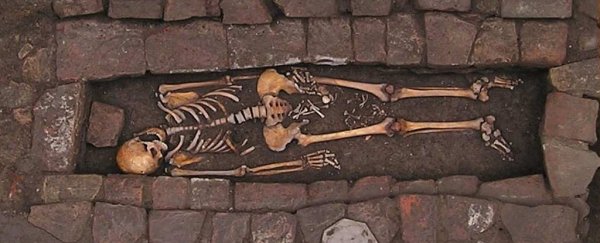A grave dating back to early medieval Italy is a sad testament to the horrors of medicine in the Dark Ages. The skeletal remains of a young woman were found with the skeleton of a foetus between her thighs - and a hole in her skull researchers have determined was likely the result of a medical treatment.
Found in 2010 in Imola, Bologna, the well-preserved remains were face up in a brick coffin - indicating a proper burial. Initial analysis dated it back to the Lombard period, around the 7th and 8th centuries CE. But the foetus and the head injury warranted further investigation.
Researchers from the University of Ferrara and the University of Bologna determined the woman to be aged between 25 and 35 years, while the foetus - based on the length of its femur - was around 38 weeks. A full-term pregnancy is 40 weeks, so the mother was extremely close to giving birth when she died.
In the grave, the foetus was in an unusual position - its head and torso between her thighs, but its legs were in her pelvic cavity, as though it had been partially expelled. This, the researchers determined, was consistent with a phenomenon known as "coffin birth".
 (Pasini et al./World Neurosurgery)
(Pasini et al./World Neurosurgery)
Also known as post-mortem foetal extrusion, it's a rare event thought to occur because of the natural processes of decomposition. Although it's never been observed first-hand, researchers believe that the gasses that build up in the body cavities of a corpse during putrefaction force the foetus out of the body.
Because there's already a passage for the foetus - the vaginal canal - that's where it goes, resulting in the corpse of a pregnant woman appearing to have given birth after death. But the process could be much messier than giving live birth.
"The cervix shouldn't relax with death after rigor mortis disappears," gynaecologist Jen Gunter told Forbes. "I suspect that what happens is the pressure from the gas builds up, and the dead foetus is delivered through a rupture – it basically blows a hole through the uterus into the vagina, as the vagina is much thinner than the cervix."
Coffin birth is pretty rare and thought to be even rarer nowadays, due to the removal of bodily fluids and the chemicals with which corpses are imbued prior to burial - so it's noteworthy when archaeological examples of it are found.
However, the researchers believe that the pregnancy, the death, and the hole found in the corpse's skull in this particular case could all be related.
According to their paper, the research team believe that the hole, drilled in the centre of the skull, was caused by trepanation - the old medical practice of drilling a hole in the skull to treat a variety of ailments.
 (Pasini et al./World Neurosurgery)
(Pasini et al./World Neurosurgery)
The hole itself showed features that may have been caused by a circular cutting tool, as well as three parallel horizontal grooves similar to grooves that have been observed in other cases of trepanation.
In addition, they found a small linear cut-mark on the skull above the hole - consistent with a cut that may have been made to peel back the scalp in preparation for drilling.
The bone even showed signs of healing, indicating the woman lived for at least a week after the procedure.
So why would you want to drill into the skull of a heavily pregnant woman? It was probably to do with pre-eclampsia.
"Since trepanation was once often used in the treatment of hypertension to reduce blood pressure in the skull, we theorised that this lesion may be associated to the treatment of a hypertensive pregnancy disorder such as preeclampsia," the researchers wrote in their paper.
"Eclampsia is the outcome of seizures of preeclampsia, which can affect women after the 20th week of pregnancy, and hypertensive diseases are still nowadays the first cause of maternal death.
"Some of the most common manifestations of this disease are high fever, convulsions, consistent frontal and occipital cephalalgia, high intracranial pressure, cerebral hemorrhage. All these symptoms, from prehistory to the 20th century, used to be treated with trepanation."
Despite - or because of - the treatment, the woman didn't pull through. Or, the paper notes, she could have died as a result of labour complications. Nevertheless, the discovery is a fascinating (if grisly) one, combining both a rare case of medieval trepanation with an even rarer case of coffin birth.
The team's paper has been published in the journal World Neurosurgery.
